DataScience Workbook / 09. Project Management / 1.2 Project Strategy & Design / 1.2.1 Project Design vs Project Framework
Introduction
In project management, understanding the interplay between Project Strategy, Project Design, and Project Framework is crucial. Each element serves a distinct but complementary purpose. By distinguishing between these three elements, we can better understand their individual contributions to project success.
| Project Startegy | Project Design | Project Framework |
|---|---|---|
| vision and end goals | detailed plan to achieve those goals | structure, processes, and governance to manage and control the project |
| ensures that the project has a clear purpose and direction | translates this purpose into a detailed, actionable plan | provides the necessary structural support to manage and execute the plan effectively |
In professional project management, these elements work together to ensure that a project is well-planned, organized, and executed.
- What it is?
| Project Startegy | Project Design | Project Framework |
|---|---|---|
| It's the "why" and the "what". | It's the "how" of the project. | It's the the "who" & "when" and "rules of the game". |
| Project Strategy is the overarching vision and purpose of your project. | Project Design is the detailed plan of action. | Project Framework is about the structure and governance of the project. |
| Think of it as the compass of your project. It sets the direction and purpose, defining why you're undertaking the project and what you aim to achieve. | Think of it as the blueprint of your project. It's like a detailed plan or roadmap that outlines what you're going to do and how you're going to do it. | Consider it the rulebook and scaffolding of your project. It establishes the rules, roles, and structures that guide and support the entire project's execution. |

- key elements
| Project Startegy | Project Design | Project Framework |
|---|---|---|
| This encompasses the project's - long-term goals, - objectives, - scope analysis, - alignment with broader organizational or academic intentions and - risk management |
It includes - specific goals, - objectives, - deliverables, - timelines, and - resource planning (people, money, equipment). |
This includes - methodologies (e.g., Agile, Waterfall), - roles and responsibilities, - communication plans, and - processes for monitoring and controlling the project. |
| In a research project, the strategy would encompass - the choice of research area, - the overarching questions or hypotheses, - the significance of the research, - how it aligns with academic or organizational goals, and - how the outcomes will contribute to knowledge or practical applications. |
In a research project, the design would detail - the research methods, - types of data to be collected, - tools and techniques to be used, - the timeline for each phase of the research, and - the expected deliverables. |
In a research project, the framework would establish - the roles and responsibilities of team members and stakeholders, - the communication and reporting protocols, - the procedures for monitoring progress and quality control, - the risk management strategies, and - the guidelines for decision-making. |
- Why it matters?

| Project Startegy | Project Design | Project Framework |
|---|---|---|
| The strategy sets the direction for the project, ensuring that it aligns with overarching goals and has a clear purpose. It's like setting the destination before starting a journey. | Good project design ensures that everyone knows what needs to be done and how. It's essential for turning the strategic vision into actionable steps. | The framework provides the necessary guidance and structure, akin to the rules of a game. It ensures that all participants understand their roles and that the project remains on track. |
This comprehensive approach is particularly valuable in research projects, where strategic alignment, detailed planning, and robust governance are key to navigating the complexities and uncertainties inherent in research.
For a practical understanding of Project Strategy and Risk Management in the context of research applications, I highly recommend exploring the hands-on tutorial in this workbook. This tutorial is designed to provide you with real-world insights and actionable skills, specifically tailored to managing research projects.
Now, let’s delve into how Project Design and Project Framework can be adapted for research projects!
In this tutorial, the focus is on practicality and adaptability, ensuring that the project management practices enhance rather than hinder your research process. The goal is to strike a balance between structured management and the fluid, dynamic nature of research work.
Integrating professional project management techniques into the context of small-scale research projects is a great approach to enhance efficiency and effectiveness. It’s a bit less formal, more dynamic, and definitely more focused on the journey of discovery.
Design for Research Projects
In the dynamic landscape of research, the art of project design lies in balancing detailed planning with the flexibility to embrace the unexpected. This section delves into the core components of crafting a research project design that is both structured and adaptable, tailored to navigate the unique challenges of the research world. From setting realistic goals to smartly integrating technology, we unpack the essentials of shaping a research project that’s ready for discovery and innovation.
Core Aspects of Project Design
| PROJECT DESIGN | HOW of the project , detailed plan or roadmap |
||
|---|---|---|---|
| 1. | Goals and Objectives |  |
Clearly define what the research aims to achieve, with a focus on specificity and flexibility. |
| 2. | Deliverables | 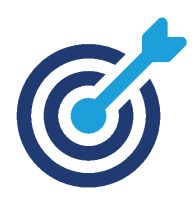 |
Identify expected outcomes such as reports, papers, new hypotheses, or other forms of knowledge dissemination. |
| 3. | Methodology Selection and Development | 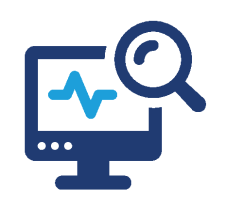 |
Tailor methodologies to best fit the research question or hypothesis, adaptable as new insights arise. |
| 4. | Resource Allocation | 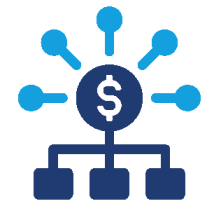 |
Efficiently manage resources, including funding, materials, knowledge, expertise, and technology. |
| 5. | Timeline and Milestone Planning |  |
Create a realistic, yet flexible timeline with key milestones, acknowledging the exploratory nature of research. |
| 6. | Decision-Making Processes | 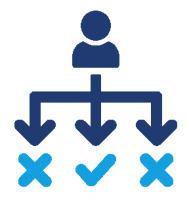 |
Establish clear, adaptable processes for making decisions in response to evolving project needs. |
Methodologies in Project Design
In the context of Project Design, “methodologies” typically refer to the specific approaches and techniques used to plan and execute the project’s tasks and activities. In a research context, this could mean choosing between experimental designs, survey methods, case studies, etc., based on the nature of the research question, available resources, and desired outcomes.
-
Detailed Planning Techniques
This includes approaches to:
- breaking down tasks,
- scheduling,
- resource allocation, and
- determining workflows.
For example, techniques like Work Breakdown Structure (WBS) or Critical Path Method (CPM) can be integral. -
Data Collection and Analysis Methods
Especially in research projects, the choice of how data is collected, analyzed, and interpreted is a key part of the project design. This could involvequalitative methods,quantitative methods, or a mixed-methods approach. -
Design Thinking and User-Centered Approaches
In projects where the end-user experience is crucial (like in product development or certain types of research), methodologies that center on user needs and iterative design can be vital. -
Risk Assessment Methods
These are techniques used to identify, analyze, and mitigate risks during the project design phase. This might includequalitative risk assessment,quantitative risk assessment, orrisk scenario planning.
Adapting Project Design in Research
-
Flexibility in Goals, Methodology, and Deliverables
Be prepared to revise goals, methodologies, and expected deliverables as new data and insights emerge. -
Dynamic Resource and Deliverable Management
Adapt resource allocation and deliverable planning in response to project progression and discoveries. -
Adaptive Timeline and Tools
Utilize tools like Gantt charts or Kanban boards for planning, but be ready to adjust timelines based on research findings. -
Iterative Decision-Making
Implement a decision-making process that can evolve with the project, accommodating new information and challenges. -
Integrating Technology Smartly
Employ technology for data collection, analysis, collaboration, and effective project management. -
Handling Uncertainty and Serendipity
Be equipped to leverage unexpected discoveries and navigate the uncertainties inherent in research projects.
Framework for Research Projects
In the intricate nature of research, the Project Framework acts as the essential scaffolding, giving shape and stability to your scholarly endeavors. It’s more than just a structural necessity; it’s the strategic orchestration of roles, processes, and guidelines that harmonize the complex elements of a research project. It’s about constructing a robust yet flexible support system that guides the project through its lifecycle. From defining clear roles to establishing adaptive processes, this section is dedicated to constructing a framework that is receptive to the unique revelations of research exploration.
Core Aspects of Project Framework
| PROJECT FRAMEWORK | WHO & WHEN , rules of the game , roles & procedures |
||
|---|---|---|---|
| 1. | Roles and Responsibilities | 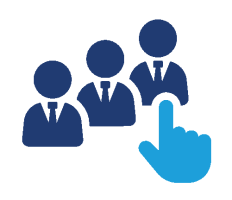 |
Clearly define and distribute roles and responsibilities within the research team, ensuring everyone knows their part in the project. |
| 2. | Communication and Reporting | 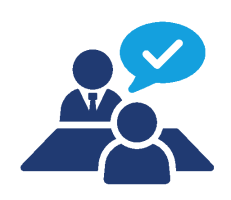 |
Establish effective communication channels and reporting mechanisms to maintain clarity and continuity throughout the project. |
| 3. | Monitoring and Quality Control | 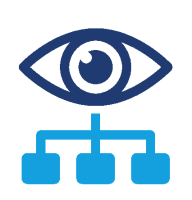 |
Implement processes for regular monitoring of progress and maintaining quality standards in line with research objectives. |
| 4. | Risk Management and Mitigation |  |
Identify potential risks and develop strategies to mitigate them, ensuring the project remains on track. |
| 5. | Governance and Decision-Making Structure | 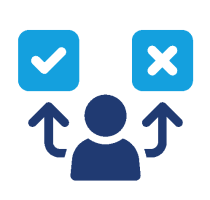 |
Create a governance structure that outlines decision-making processes and authority, providing clear guidance for project progression. |
Methodologies in Project Framework
| Agile Methodology | Waterfall Methodology |
|---|---|
| Agile is all about flexibility and iterative progress. | Waterfall is a more linear and structured approach. |
 |
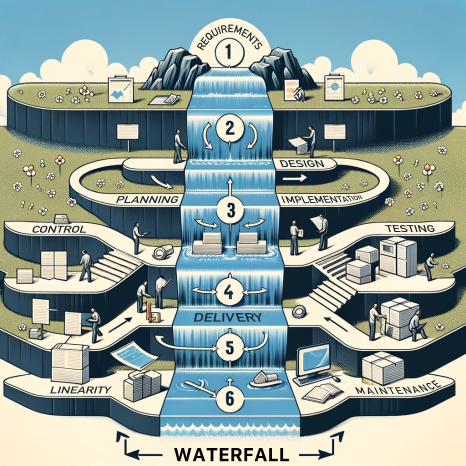 |
Agile methodology is an iterative project management approach that emphasizes continuous iteration and improvement. It originated in software development but has since been applied to various types of projects. |
Waterfall methodology is a sequential project management approach that emphasizes a linear progression through a set of predefined phases. It originated in manufacturing and construction and has been traditionally used in software development. |
Agile focuses on delivering small, workable segments of the project in an iterative manner, allowing for regular reassessment and adaptation. |
This approach relies on detailed upfront planning, clear documentation, and a stable project scope, which allows for minimal changes once the project is underway. |
| AGILE STEPS (Scrum) | WATERFALL STEPS |
| 1. Concept/Initiation 2. Planning (iterative) 3. Execution (iterative) 4. Review (iterative) 5. Release |
1. Requirements and Analysis 2. System Design 3. Implementation 4. Testing 5. Deployment or Delivery 6. Maintenance |
| The cycle repeats, with the team continually planning, executing, reviewing, and adjusting based on feedback and changing requirements. | Each phase in the Waterfall model is distinct and does not overlap with others, making it a straightforward approach. |
| What are the 3 C’s in Agile? | Essence of the Waterfall |
collaboration, coordination, communication |
linearity , planning , control |
In research, this can be particularly useful for projects that are exploratory in nature or where requirements may evolve. |
It’s suitable for research projects with well-defined stages and where changes are less likely to occur once the project has started. |
Choosing the Right Methodology
Selecting the appropriate methodology depends on the specific needs and nature of your research project. Factors like project scope, complexity, stakeholder requirements, and the level of uncertainty can influence this choice.
In simpler words, picking between Agile and Waterfall is like choosing between a road trip where you can take detours and explore (Agile) or a direct flight to your destination (Waterfall). Both have their perks and quirks, so let’s break it down:
| feature | AGILE | WATERFALL |
|---|---|---|
| Flexibility | High - can easily adapt to changes. |
Low - changes are challenging once the project starts. |
| Planning | Less initial planning, evolves with the project. | Extensive upfront planning, with detailed requirements. |
| Control | More fluid, with continuous iteration. | Highly structured, with strict control over each phase. |
| Visibility | Continuous delivery offers early and frequent insight into progress. |
Progress is typically visible only at the end of each phase. |
| Risk Management | Agile’s iterative nature allows for early detection and resolution of issues. | Risks must be identified upfront; changes later in the project can be costly. |
| Suitability | Great for exploratory projects where goals may shift. | Ideal for projects with well-defined, unchanging requirements. |
| Stakeholder Engagement | Regular stakeholder involvement and feedback. | Stakeholder involvement mainly at the beginning and end. |
| Outcome | Can result in more innovative solutions due to adaptability. |
More predictable outcomes, adhering closely to initial plans. |
In research, if your path is clear and your destination is set, Waterfall might be the way to go. But if you're in the mood for some exploration and expect a few surprises along the way, Agile could be your ticket. It's all about what fits the nature of your project best.
Adapting Project Framework in Research
-
Flexibility in Roles and Communication
Adapt roles and communication plans as the project evolves, accommodating new insights and changes in team dynamics. -
Responsive Monitoring and Adaptation
Use monitoring not just for oversight but as a tool for adaptive management, responsive to the unique developments in the research. -
Proactive Risk Management in Research Contexts
Anticipate and manage risks that are specific to research, such as data variability, ethical considerations, and funding uncertainties. -
Iterative Governance and Decision-Making
Employ a governance approach that allows for iterative decision-making, adapting to the evolving nature of research inquiries. -
Embracing Technological and Methodological Innovations
Incorporate the latest technology and methodologies in framework planning, enhancing the research process and outcomes.
Hands-on Case Study:
Project Design and Project Framework
Embark on a practical journey through the world of bioinformatics as we develop a tool for genome sequencing data analysis. This hands-on case study offers a real-world glimpse into the intricacies of project design and framework in the rapidly evolving field of bioinformatics. You’ll experience firsthand how to manage a project that sits at the intersection of biology, data science, and technology. This case study is designed to provide you with a practical understanding of both Agile and Waterfall project management methodologies in the context of a complex and evolving field.
